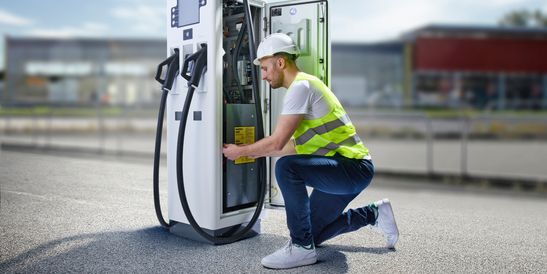Charging at home – What’s important
- Private
- Charging
- Knowledge
- 29.7.2021
- Reading Time: {{readingTime}} min

Contents

1. I am only a tenant - how do I get the electricity for charging?
Charging an electric car on rented property should always be arranged together with the landlord, as existing installations may not be designed for charging currents. The landlord's consent is required anyway for structural changes such as the installation of a power line. The landlord may even finance the installation of charging infrastructure because it increases the value of the property or real estate.
2. How fast can I charge at home?
An important factor when charging with household AC power is the power of the on-board charger in the vehicle. A maximum of 7.4 kW is theoretically possible with single-phase charging (with the appropriate supply line), but in Germany, Austria and Switzerland the power is limited to 3.7 kW in the private sector for safety reasons. All e-cars that can charge three-phase are capable of 11 kW, some even of 22 kW. An electric car with a 55 kWh battery capacity can thus be fully charged in 5 or even 2.5 hours. Charging at 22 kW requires testing by the grid operator.
3. Do I really need a wallbox?
If you want the flexibility of higher charging speeds of up to 22 kW, the safety of an installation specially made for continuous use and the convenient operation of a tidy charging station, you could not be better off than with a wallbox. The emergency charging cable that comes with the vehicle for the household socket is only an emergency solution and in no way intended for regular use.
4. Do I need an electrician?
Whether in a rental property or in owned housing - the installation of a wallbox by an expert is not only advisable, but necessary. In Germany, grid operators require a registration of the wallbox as well as a test of the peripheral device [in Austria the obligation to register varies from province to province]. The installation of the wallbox itself is not very complex, the focus is on the supply line and the protection mechanisms. The advantage of wallboxes from KEBA: An expensive type B RCD is not necessary thanks to integrated DC residual current monitoring.
5. Can I use my own solar power?
Yes, but this is not possible with every wallbox. When purchasing a wallbox, it is therefore important to ensure that the integration into a photovoltaic system is possible so that it can communicate with the energy management system of the PV system. The wallbox models of the P30 c- and x-series from KEBA meet these requirements.
6. How much does it cost to charge at home?
The cost of a kilowatt hour of a home wallbox is the same as that of normal household electricity. As a rule, refuelling at home is noticeably cheaper than at public charging stations and is therefore not only practical, but also makes economic sense. Nevertheless, prices can vary greatly from provider to provider, from country to country and depending on the electricity mix. A wallbox itself costs between 600 and 1,600 euros, depending on its features.







